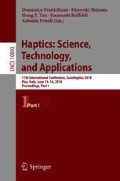Abstract
One method of presenting a pseudo-force sensation is based on a phenomenon called the hanger reflex, in which placement of a wire hanger on the head induces involuntary head rotation. The main cause of this phenomenon is considered to be a pseudo-force sensation generated by lateral displacement of the skin via skin compression. However, the relationship between the physical amount of skin displacement and the strength of the illusion has not been thoroughly investigated, impeding optimization of a device that elicits the hanger reflex. As a first step towards developing an optimized hanger reflex device, we describe a method for measuring the amount of skin deformation during the occurrence of the hanger reflex, by using optically observable artificial skin. We report the correlation between deformation of the artificial skin and head rotation angle, which had previously been reported only qualitatively.
Access this chapter
Tax calculation will be finalised at checkout
Purchases are for personal use only
References
Minamizawa, K., Prattichizzo, D., Tachi, S.: Simplified design of haptic display by extending one-point kinesthetic feedback to multipoint tactile feedback. In: Proceedings of IEEE Haptics Symposium 2010, Waltham, MA, USA, pp. 257–260 (2010)
Amemiya, T., Gomi, H.: Distinct pseudo-attraction force sensation by a thumb-sized vibrator that oscillates asymmetrically. In: Auvray, M., Duriez, C. (eds.) EUROHAPTICS 2014. LNCS, vol. 8619, pp. 88–95. Springer, Heidelberg (2014). https://doi.org/10.1007/978-3-662-44196-1_12
Rekimoto, J.: Traxion: a tactile interaction device with virtual force sensation. In: Proceedings of 26th ACM Symposium User Interface Software and Tech, St. Andrews, UK, pp. 427–431 (2013)
Tanabe, T., Yano, H., Iwata, H.: Proposal and implementation of non-grounded translational force and torque display using two vibration speakers. In: Hasegawa, S., Konyo, M., Kyung, K.-U., Nojima, T., Kajimoto, H. (eds.) AsiaHaptics 2016. LNEE, vol. 432, pp. 187–192. Springer, Singapore (2018). https://doi.org/10.1007/978-981-10-4157-0_32
Sato, M., Matsue, R., Hashimoto, Y., Kajimoto, H.: Development of a head rotation interface by using hanger reflex. In: Proceedings of 18th IEEE International Symposium Robot Human Interactive Communication (RO-MAN), Toyama, Japan, pp. 534–538 (2009)
Kon, Y., Nakamura, T., Sato, M., Asahi, T., Kajimoto, H.: Hanger reflex of the head and waist with translational and rotational force perception. In: Hasegawa, S., Konyo, M., Kyung, K.-U., Nojima, T., Kajimoto, H. (eds.) AsiaHaptics 2016. LNEE, vol. 432, pp. 217–223. Springer, Singapore (2018). https://doi.org/10.1007/978-981-10-4157-0_38
Sato, M., Nakamura, T., Kajimoto, H.: Movement and pseudo-haptics induced by skin lateral deformation in hanger reflex. In: Proceedings of SIG TeleXistence 5th Workshop (2014) (in Japanese)
Nakamura, T., Nishimura, N., Sato, M., Kajimoto, H.: Application of hanger reflex to wrist and waist. In: Proceedings of IEEE VR 2014, Minneapolis, MN, USA, pp. 181–182 (2014)
Kon, Y., Nakamura, N., Sato, M., Kajimoto, H.: Effect of hanger reflex on walking. In: Proceedings of IEEE Haptics Symposium 2016, Philadelphia, PA, USA, pp. 313–318 (2016)
Begej, S.: Planar and finger-shaped optical tactile sensors for robotic applications. Proc. IEEE J. Robot. Autom. 4(5), 472–484 (1988)
Kevin, V., Mizota, T., Kawakami, N., Kamiyama, K., Kajimoto, H., Tachi, S.: GelForce: a vision-based traction field computer interface. In: Proceedings of CHI EA 2005 CHI 2005 Extended Abstracts on Human Factors in Computing Systems, Portland, Oregon, USA, pp. 1154–1155 (2005)
Yamaguchi, A., Christopher, G.: Implementing tactile behaviors using FingerVision. In: Proceedings of 17th IEEE-RAS International Conference on Humanoid Robots, Birmingham, UK, pp. 1045–1051 (2017)
Acknowledgment
This work was supported by JSPS KAKENHI Grant Number 18H04110.
Author information
Authors and Affiliations
Corresponding authors
Editor information
Editors and Affiliations
Rights and permissions
Copyright information
© 2018 Springer International Publishing AG, part of Springer Nature
About this paper
Cite this paper
Miyakami, M., Kon, Y., Nakamura, T., Kajimoto, H. (2018). Optimization of the Hanger Reflex (I): Examining the Correlation Between Skin Deformation and Illusion Intensity. In: Prattichizzo, D., Shinoda, H., Tan, H., Ruffaldi, E., Frisoli, A. (eds) Haptics: Science, Technology, and Applications. EuroHaptics 2018. Lecture Notes in Computer Science(), vol 10893. Springer, Cham. https://doi.org/10.1007/978-3-319-93445-7_4
Download citation
DOI: https://doi.org/10.1007/978-3-319-93445-7_4
Published:
Publisher Name: Springer, Cham
Print ISBN: 978-3-319-93444-0
Online ISBN: 978-3-319-93445-7
eBook Packages: Computer ScienceComputer Science (R0)

